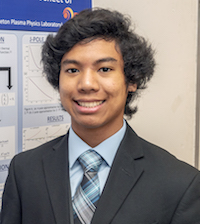
Manfred Virgil Ambat
University of California, Berkeley
Dispersion calculation for lower hybrid waves in the current sheet of reconnection with guide field
Manfred Virgil Ambat, Jongsoo Yoo
Lower hybrid waves have been observed in the current sheet during reconnection with guide field in both the Magnetic Reconnection Experiment (MRX) and Magnetospheric Multiscale (MMS) mission. The observed waves produce density fluctuations correlated with electric field, generating anomalous resistivity. To understand the excitation mechanism and propagation of the lower hybrid waves, the dispersion relation and growth rate are calculated by a linear calculation [Ji et al. 2005]. In this local calculation, both parallel and perpendicular electron flows exist in the ion rest frame. Based on the measured value of the phase velocity that is comparable to the ion thermal speed, it is important to include ion thermal effects in the calculation. We use the J-pole expansion of the plasma dispersion function to capture the ion thermal effects in the dispersion relation. Results with ion thermal effects will be compared with those from the cold ion limit.
Poster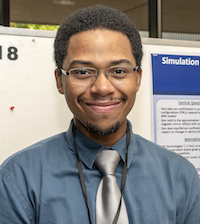
Nathaniel Barbour
Yale University
Simulation study of energetic ion confinement response to MHD modes in FRC
Nathaniel Barbour, Elena Belova and Masaaki Yamada
Energetic ion confinement is studied in the context of a representative prolate field-reversed configuration equilibrium with kinetic parameter S* < 10. Test particle simulations are performed following full orbits for thermal and fast ions using the HYM code. Ion confinement is investigated in the presence of a set of the small amplitude global MHD tilt and rotational modes, and its dependence on the excited mode numbers and the energy of the fast ions is analyzed. Additionally, the impact of the mirror coils on particle confinement is quantified. The recent results of the Tri Alpha Energy experiment motivates the work, as it is imperative to understand how fast ions resulting from NBI interact with MHD modes.
Poster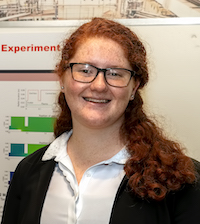
Kaitlyn Butler
University of Illinois at Urbana Champaign
DSMC Modeling of H2 in a Lithium Vapor Box Concept
Kaitlyn Butler, J. Schwartz, and R. Goldston
One of the bigger problems in the tokamak community is how to decrease the heat load that the divertor experiences during a run. At the Princeton Plasma Physics Laboratory (PPPL), a concept is begin developed called the Lithium Vapor Box Concept that involves using a cloud of lithium to detach a plasma and therefore decrease the heat load on the surfaces of the divertor. One of the first steps is to prove that hydrogen cannot be used to detach the plasma on its own. If this were the case then any results with lithium could be easily disputed as the result of the hydrogen.
Poster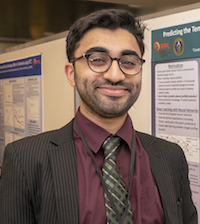
Jalal Butt
Central Connecticut State University
Predicting the Temporal Evolution of Tokamak Plasma Profiles with Deep Learning
Jalal Butt, Egemen Kolemen
Plasma stability is a major challenge in the development of commercially feasible fusion energy. Codes that determine the stability of plasmas have been developed for study, many of which take radial plasma profiles as inputs. If the temporal evolution of the profiles was known prior to their realization, the future stability of the plasma could be determined, and future undesired plasma stability conditions can be controlled and manipulated to produce desired ones. A data-driven approach was taken to predict the temporal evolution of the plasma profiles. A Long Short-Term Memory recurrent neural network (LSTM-RNN) capable of learning temporal dynamic behavior was trained to predict the evolution of ne, ni, Te, Ti, and Rot. several hundred milliseconds in the future at a time using historical knowledge of the past 150-ms of profile and zero-dimensional time-trace (NBI, ECH, and gas puffing) data. Preliminary model predictions exhibit relatively high accuracies, and demonstrates capability to predict the onset of physically significant phenomena, such as ion density profile "hollowing". The model’s prediction capability is being further explored using recently awarded NERSC computing resources on Cori and Edison supercomputers. The model has the potential to study the temporal evolution of plasma transport in conjunction with physics-based transport models.
Poster
Natalie Cannon
Santiago Canyon College
CCI
Investigation of H/He Isotope Separation via Pd Foil
Natalie Cannon, S.A Cohen, B. Koel, L. Buzi
Field-Reversed Configuration (FRC) fusion devices are a type of magnetic confinement device that utilizes odd-parity rotating magnetic fields to induce closed field lines. The D3He fuel is aneutronic, however, deuterium atoms in the plasma can fuse with each other to either produce tritium (T) or 3He. The T must be extracted in order to have a clean plasma, and in the future can then be stored, and through the decay of T it can breed more 3He fuel. High Z, large surface area materials, such as Palladium (Pd), have been shown to exhibit superpermeability of atomized and ionized H in a plasma. Pd has a high H sorption rate and high permeability through conversion of H to a metallic hydride when heated to high temperatures, which increases H diffusion. At low temperatures, surface oxides and carbides dissolve, decreasing Pd impurities. We will report data on H/He permeability in Pd foil at a temperature range of 300-800 K, focusing on the effects of pressure and temperature.
Poster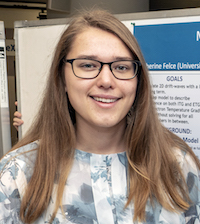
Catherine Felce
University of Oxford
Modeling 2D Drift-Wave Turbulence with the Terry-Horton Equations
Catherine Felce, Greg Hammett, and Noah Mandell
This research investigates plasma turbulence in the bad curvature region of a tokamak. First, we simulated ion-guiding-center density fluctuations governed by the Terry-Horton fluid equations. The simulations verified that enhanced zonal flows reduce radial particle transport. Then, we outline a toy model which can be used to describe multi-scale turbulence, covering both ion and electron scales. We include some preliminary results from the simulations of the fluid equations for this model. This multi-scale simulation gives density fluctuations for both ion and electron guiding-center densities. Both sets of simulations are implemented using Dedalus[7], a Python framework for spectrally solving differential equations. The equations are solved on a square domain, with periodic boundary conditions, representing a square section of the poloidal cross-section of a tokamak.
Poster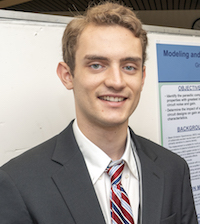
Grant Giesbrecht
Centre College
Modeling and Simulation of Photodiode Circuits for Beam Emission Spectroscopy
Grant Giesbrecht, David Smith, George McKee, Lucas Morton, Matt Kreite
Beam Emission Spectroscopy (BES) systems can measure localized plasma density in a fusion reactor. BES systems use photodiodes to detect the emission intensity from collisionally excited neutral beam particles. It follows that low-noise photodiode amplifier circuits are integral to achieving accurate BES measurements. In this study, we used LTspice to simulate the photodetector circuits used in NSTX to determine what circuit parameters have the strongest effect on photodetector response and noise. Ultimately, we will use this information to aid in designing a BES system that uses a 2D photodiode array in place of individual photodiodes distributed among multiple PCBs. Examples of parameters we analyzed include parasitic capacitances and inductances of the photodiode and the first amplifier stage’s JFET. We performed the analysis by modeling the component of interest (eg. photodiode) as a network of discrete components and studying circuit behavior as we varied the component parameters. This research was funded by the US Department of Energy’s Science Undergraduate Laboratory Internship program.
Poster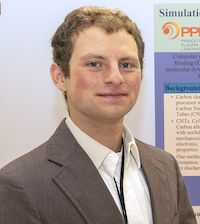
Bennett Greenberg
Rutgers University
Simulations of Carbon Chain Growth and Evolution with Varying Temperature
Bennett Greenberg, Igor D Kaganovich, Alexander Khrabry, Longtao Han, Stephane Ethier, Predrag Krstic
Computer simulations were used to study the growth of carbon nanotubes created by a plasma arc discharge. Density Functional Theory Tight-Binding (DFTB+) and Thermodynamics codes were used for the calculations, and the results of each code were compared. Quantum-classical molecular dynamics was carried out using the DFTB method and a Nose-Hoover thermostat. The thermal dynamics code uses the Gibbs ensemble to find the most probable states of the system. Evolution of the carbon chain length as a function of temperature was studied.
Poster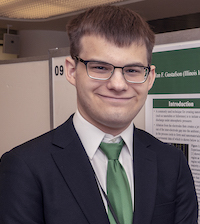
Ian F. Gustafson
Illinois Institute of Technology
Numerical Simulation of Arc Initiated Jet Flow
Ian F. Gustafson, Andrei Khodak, Alexander Khrabry, Igor Kaganovich
Arc discharges under atmospheric pressure are often used for nanomaterial synthesis (e.g. boron nitride/carbon nanotubes or fullerenes). Feedstock for nanomaterial synthesis is produced by ablation of the arc electrodes, creating a jet that propagates from the inter- electrode gap into the ambient background gas [1]. Flow patterns in the jet were obtained analytically using boundary layer theory. Theoretical limits were verified via comparison to computational fluid dynamics (CFD) simulations. These simulations were based on a full set of Navier-Stokes equations and were, in turn, validated via comparison to experimental data reported by S. Yatom et al. ["Synthesis of nanoparticles in carbon arc: measurements and modeling", MRS. Comm. (2018), published online, doi: 10.1557/mrc.2018.91.]. For this research, the effects of boundary conditions, viscosity, and other variables on the flow pattern were studied both analytically and numerically. Additionally, the jet shape distortion caused by convection of the surrounding gas (heated by the electrodes) was studied.
Poster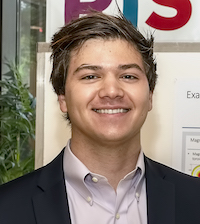
Daniel A. Korsun
MIT
Examination of Current Profiles in Magnetic Islands During RF Current Condensation
Daniel A. Korsun, Allan H. Reiman, Nathaniel J. Fisch
In magnetic fusion devices, the growth of magnetic islands degrades plasma confinement. These islands are usually stabilized by using radio frequency (RF) waves to drive current directly into their centers. This stabilization method requires constant monitoring and readjustment to accommodate for island formation and movement. Theoretical work has demonstrated that due to the increased electron temperature at the centers of magnetic islands, current driven by lower hybrid and electron cyclotron waves should naturally localize to the island centers, in an effect called the RF current condensation effect. This paper attempts to investigate some of the manifestations of current condensation in magnetic islands. Using the steady-state heat diffusion equation in a magnetic island, power deposition profiles and current condensation behavior within magnetic islands are examined. In order to gain a more complete understanding of the effects of wave depletion on RF current condensation, a variety of wave damping and initial power density treatments are explored. This work demonstrates that RF current condensation should cause significantly greater current to be driven at island centers than island peripheries, providing enduring stabilization of magnetic islands without the need for precise steering of the RF waves. This suggests that both existing and future fusion devices could stabilize magnetic islands without a heavy reliance on active feedback control.
Poster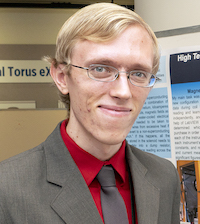
Gregory Krueper
University of California, Irvine
High Temperature Superconducting Magnets for Fusion Applications
Gregory Krueper, Yuhu Zhai
A crucial component to achieve burning plasma for the next generation magnetic confinement fusion devices will be the reliable and robust high-field and possibly high-temperature superconducting magnets. Of particular importance to the advanced tokamak design is the ability of the central solenoid magnet to quickly charge up to high current level; this provides sufficient magnetic flux swing that induces a toroidal plasma current for plasma initiation. A candidate material for these magnets, Nb3Sn, has been shown to have performance degradation under high Lorentz force that is induced when the magnet is energized at a few 10s of kilo-Amperes. Here, we use a simplified coil fabrication process to make a scaled Nb3Sn superconducting prototype and test its current charging and discharging behaviors. In addition, the test data obtained from previous experiments on the prototype coils in collaboration with the University of Geneva are analyzed and discussed. In particular, the coil behavior at its near critical current level will reveal the coil performance limit given the simplified fabrication technique used for this coil. We address the important issues of sta- bility, current sharing among turns, quench protection, and energy distribution within the coil winding pack.
Poster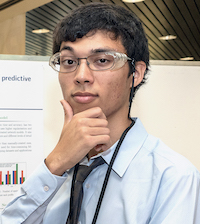
Justin Kunimune
Olin College of Engineering
Optimization and application of neural network models for accelerated predictive modelling of NSTX-U
Justin Kunimune, Vaish Gajaraj, Dan Boyer, Michael Zarnstoff
A critical component of advancing modern fusion devices to cost-effective energy sources will be model-based control and scenario development. Specically, a hierarchy of models with varying levels of complexity, speed, and precision is necessary to meet the various needs of the design process. Neural networks have been demonstrated to be capable of producing fast and reliable models of fusion plasmas, and their ability to have their levels of complexity tuned make them apt candidates for the needed hierarchy. However, each network has many hyperparameters, the tuning of which is time-consuming and does not always result in the best possible model. An algorithm has been developed to systematically generate and optimize neural networks of varying levels of complexity by tuning hyperparameters for the purposes of accelerated predictive models of NSTX-U. It uses a genetic algorithm to rapidly arrive at optimal model parameters that could previously be found only through exhaustive grid searches. This algorithm was used to tune and train neural networks of neutral beam deposition trained on the NUBEAM code. This new approach yields more optimal neural networks and enables tuning the trade-off of model fidelity and computation time based on the requirements of any given application.
Poster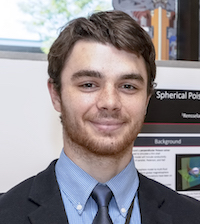
Stephen Majeski
Rensselaer Polytechnic Institute
Spherical Poisson Solver for Global Multi-fluid Magnetosphere Simulations
Stephen Majeski, Ammar Hakim, Amitava Bhattacharjee
The development of a thin-shell ionospheric model is required for simulation of space weather on Earth as well as other planets in the solar system. Our goal is to couple this ionosphere model to multi-fluid solvers in Gkeyll to perform global magnetosphere simula- tions. Presented is a generalized coordinate solver which finds solutions to the perpendicular Poisson equation on a spherical shell. A finite volume method is used for its conservative characteristics, also taking advantage of the metric tensor in order to convert between ar- bitrary 2D logical coordinates and 3D physical coordinates. This provides the ability to use specialized quadrilateral maps which eliminate the spherical-polar singularity at the poles of a sphere. The source is obtained via radial current density along magnetic field lines, and potential on the sphere surface informs potential along field lines further from the ionosphere.
Poster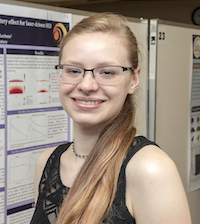
Jill Peery
Willamette University
Kinetic simulation of magnetic field generation via the Biermann Battery effect for laser-driven HED experimental conditions
Jill Peery, Jack Matteucci, Will Fox, Derek Schaeffer, Kirill Lezhnin
The Biermann Battery effect is one of the few mechanisms known to spontaneously generate magnetic fields in plasmas. Recently, this effect, which operates through a non-collinearity of the gradients in electron density and temperature, has been used to generate strong magnetic fields (10-100 T) in High Energy Density (HED) plasma experiments using high-intensity lasers. Recent kinetic simulations have investigated this effect under model profiles of density and temperature; however, connection of these results to physical experiments, which evolve dynamically, has limited applicability. Using fully kinetic, particle-in-cell simulations, we are able to model the laser ablation process from a flat foil, including the self-consistent generation of the magnetic field via the Biermann effect, allowing for direct connection to experiments. We characterize Biermann generation (both maximum field and total flux generated with respect to time) as a function of the laser deposition profile, laser spot radius, the systems collisionality, the ion species, and the density of the background population. This work allows for a direct characterization of the expected magnetic field generation solely based on the HED experimental parameters.
Poster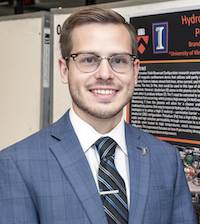
Brandon Pelc
University of Illinois at Urbana-Champaign
Hydrogen and Helium Isotope Separation by Permeation Through a Palladium Foil
Brandon Pelc, S. Cohen, B. Koel, L. Buzi
The Princeton Field-Reversed Configuration research experiment is a type of magnetic confinement device that utilizes odd-parity rotating magnetic fields to induce closed field lines, drive current, and heat the plasma. The fuel, D-3He, that would be used in this type of device is aneutronic. However, deuterium (D) atoms in the plasma can fuse with each other to produce tritium (T). The T must be extracted to stop D-T reactions from occurring, which produce high energy (14 MeV) neutrons. Removing T from the plasma will allow for a cleaner and lower radioactivity plasma. One way to separate Hydrogen (H) and Helium (He) isotopes is to utilize a high Z material – permeation barrier – high Z material (ZBZ) configuration. Palladium (Pd) has a high H/He sorption rate and high selective permeability through conversion to a metallic hydride when heated to high temperatures, which increases H/He diffusion. This experiment focuses on how H permeability through a Pd foil is affected by temperature and pressure. In the conducted experiments, H and D were found to permeate through the Pd, while other atoms did not permeate which confirmed Pd selective permeability. The permeation was found to be temperature dependent, which was expected prior to the experiments. An increase in temperature was found to increase the permeation rate through the foil. Atomic H created in an unaccelerated ECR plasma source was found to be important in the overall permeation. Experimental values of the frequency factor and activation energy were close to those found in literature. With confirmation of selective H/D permeation, further experiments will be conducted.
Poster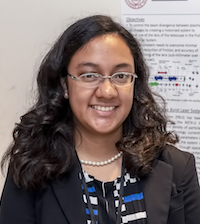
Samantha Pereira
Cornell University
Development of a Motorized Telescope for the Pulse-Burst Laser System
Samantha Pereira, Richard Upcavage, Ahmed Diallo
The Pulse-Burst Laser System (PBLS) has been installed and commissioned on NSTX-U to measure the temperature and density of particles in the plasma. This system is part of the NSTX-U Thomson scattering system and will be operated at 30 Hz continuously, and 1 kHz and 10 kHz in burst mode. To control the beam divergence, a telescope is used after the oscillator in the laser cavity. Here, we develop and model a motorized telescope to enable the control of the beam divergence between plasma discharges. The design constraints are minimal footprint (7 cm by 15 cm), reduction of friction on the collar where the lens translates, and the accuracy of the positioning of lens (sub-millimeter over 25-30 mm travel) by the motorized system. By analyzing the telescope, an apparatus was developed to use a mechanical advantage to increase the actuator’s travel.
Poster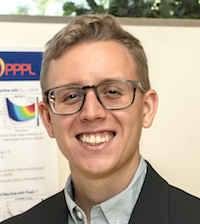
Conor Perks
North Carolina State University
Clarifying the Role of Aspect Ratio in Tokamak Design Studies
Conor Perks, Walter Guttenfelder, Jonathan Menard
There are many perceived benefits of going to low aspect ratio for tokamak reactor concepts, such as increased stability limits (beta, elongation) and potentially larger bootstrap fraction, all in a device at smaller major radius (i.e. more compact). However, these potential benefits must be balanced by the reduction in achievable on-axis magnetic field, the need for inner wall shielding and central solenoid, and the potentially larger mechanical stresses in a tighter configuration. In this work, we aim to clarify how the role of aspect ratio enters 0D design studies using various assumptions on, e.g. the target mission (high power net-electric DEMO, low power net electric Pilot Plant, high neutron fluence FNSF), stability and confinement physics, magnet technology (HTS, LTS, copper), and heating & current drive technology (RF, NBI). Different constraints are used to aid comparison and explore sensitivities in the design studies.
Poster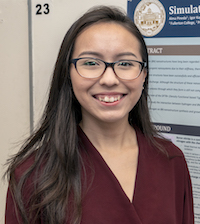
Alma Pineda
Fullerton College
CCI
Simulating Boron Nitride Nanostructure Interactions
Alma Pineda, Igor Kaganovich, Stephane Ethier, Longtao Han
Boron nitride (BN) nanostructures have long been regarded as one of the most promising inorganic nanosystems due to their stiffness, thermal conductivity, and stability. These structures have been successfully and efficiently synthesized using plasma arc discharge. Although the structure of these nanosystems have long been studied, the process through which they form is still not completely understood. Using the latest version of the DFTB+ (Density Functional based Tight Binding) code, we were able to study the interaction between hydrogen and BN nanotubules and the effects of hydrogen on BN nanostructure synthesis and growth.
Poster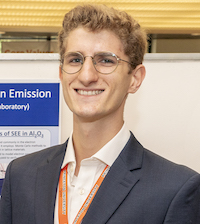
Nikola Protic
Cornell University
Discharging of Dielectric Materials as Related to Secondary Electron Emission
Nikola Protic, Yevgeny Raitses
Secondary electron emission (SEE) from dielectric materials is relevant to a number of plasma applications such as Hall thrusters, surface discharges, plasma processing etc. Measurement of SEE properties from non- conductive and purely conductive materials is usually performed, at a minimum, in high vacuum environments using pulsed electron guns. Selecting pulse duration and current minimizes undesired surface charging effects on SEE measurements; however, dielectric surface charging is unavoidable; especially negative charging due to SEE yields (ratio of secondary to primary electron fluxes) of less than 1. Thus, it is important to study how charging affects the accuracy of SEE measurements. In this work, we investigate these effects for SEE from ceramic materials (e.g. Al2O3, boron nitride) used in the above plasma applications, and explore discharging techniques such as substrate heating.
Poster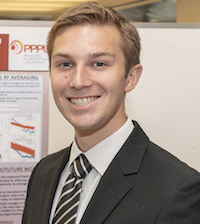
Parker Roberts
Berry College
Emissive Probe Measurements with ICRF Waves in LAPD
Parker Roberts, Rory Perkins, Troy Carter
Plasma heating using waves in the ion cyclotron range of frequencies (ICRF) is common in fusion experiments but frequently causes an unacceptable rise in metallic impurities. The commonly accepted source of these impurities is radio-frequency(RF) rectification, a nonlinear sheath phenomenon in which an oscillating electric field leads to rectified increase of both electron current and plasma voltage across the sheath, with the latter contributing to the sputtering of metallic particles from the walls into the plasma. Experiments to study this phenomenon have been completed at the Large Plasma Device (LaPD) located at UCLA using a single-strap ICRF-like antenna with about 100 kW of power and include measurements from various probes, including floating probes and emissive probes. These probes are found to be susceptible to various wave effects that lead to inaccuracies in measurement of plasma potential, which are compounded with fluctuations in low-density plasma regions with n_e < 1E18 m^−3.
Poster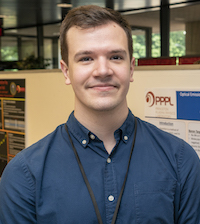
John Rodman
Syracuse University
Optical Emission Spectroscopy Study of the Plume During Laser Ablation of Boron-Rich Target
John Rodman, Shurik Yatom, Yevgeny Raitses
We report on the results of optical emission spectroscopy investigation of the ablation plume, produced after pulsed laser irradiation of B and BN targets in N2 environment at pressure of 400 Torr. A pulsed Nd: YAG laser, 355 nm wavelength with duration of ~7 ns, was employed to irradiate the boron-rich target. The laser fluence was set at ~9 J/cm2 at the surface of the target. The chemical species dominant in the ablation plume were identified via their optical emission spectra, collected at different spatial regions of the plume. Temporal evolution of the emission of several species was studied as well. The BN target plume is rich in molecular species and atomic species, both B and N in different charge states as well as BN and BNB, while the plume of the B target contained only atomic B. The study allows an insight in the physics and the chemical kinetics of the laser ablation of boron-rich targets.
Poster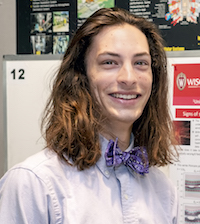
Jack Schroeder
University of Wisconsin, Madison
Investigation of Stochastic Heating in Low Collisionality Plasmas
Jack Schroeder, Ammar Hakim, Jimmy Juno, Jason TenBarge
The effect of stochastic heating in plasma is important in understanding the heating of the solar corona and the solar wind. With the recent launch of the Parker Solar Probe Plus that will gather unprecedented data of the solar wind and corona, further theoretical investigation of stochastic heating processes is desired to compare with experimental data. In this study we use the code Gkeyll to solve the Vlasov-Maxwell equations for the evolution of a plasma distribution function. Using a continuum solver avoids numerical issues such as particle noise characteristic of traditional particle-in-cell methods. We investigate the evolution of a distribution function in electromagnetic field configurations such as those observed in solar wind conditions. In addition to test particle simulations, we compare to distributions evolved including particle collision effect, and distributions evolved self- consistently, such that the particle motion feeds back to the driving electromagnetic field. Energy transfer from fields to particles will be studied to determine the extent to which stochastic motion of particles leads to particle heating.
Poster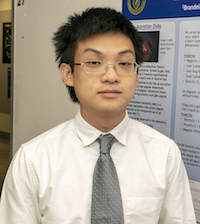
Kevin Wang
Brandeis University
Working Towards MRI Detection in the Laboratory
Kevin Wang, Erik Gilson, Hantao Ji, Himawan Winarto
Accretion disks are a ubiquitous feature throughout the universe, formed as gas, dust, and plasma spiral in towards a gravitational source such as a black hole or neutron star. Due to conservation of angular momentum, particles moving outward must gain angular momentum. Magnetorotational Instability (MRI) is a predicted mechanism that allows angular momentum to be transported out of an accretion disk. The MRI experiment at PPPL aims to simulate the conditions of an accretions disk and observe MRI in a laboratory setting. Shots taken around summer 2018 probed the lower end of the magnetic field strength and rotation speed region, and results were consistent with the expected behavior from the MRI model.
Poster
Gabriel Woodbury-Saudeau
University of Puerto Rico, Rio Piedras
Numerical Study of Isotope Effect in Tokamaks using GTC
Gabriel Woodbury-Saudeau, S. Ethier, W.W. Lee
Gyrokinetic particle simulations were used to study the effects of hydrogen isotopes on microturbulence. GTC, a well-known parallel code was used to run the simulations of ion temperature gradient (ITG) driven microturbulence for the three isotopes under the same conditions. We want to study this turbulence because if we are able to reduce it, the reactors will be able to perform more efficiently. In this study we focused on the ion thermal diffusivity, ITG growth rate, and spectral content, as these were studied in the past and we wanted to see what results more powerful simulations could provide. In our simulations we found that there was a need to increase the number of particles per cell and toroidal planes to achieve more conclusive results. When we increased those two numbers we saw our results converge to more promising values. It would be interesting to see if the trend continues as we increase the number of particles per cell and planes, and see if the convergence continues, and if we can find a point at which we can get the most accurate results, while minimizing the size of the simulations. The comparison between the ion thermal diffusivity of the three species gave favorable results, as did the growth rate study. The values found for tritium were lower in both studies, which would imply less turbulence in that plasma, and as a result better magnetic confinement, which would lead to reactors performing better. Spectral analysis of turbulence had similar results. ITG instability develops a broader spectrum in hydrogen while tritium’s is much narrower. This shows that tritium plasma has a lesser amount of turbulence than when compared to hydrogen. These results are promising, and they imply that future Deuterium-Tritium experiments at reactors such as JET and ITER could have great success.
Poster